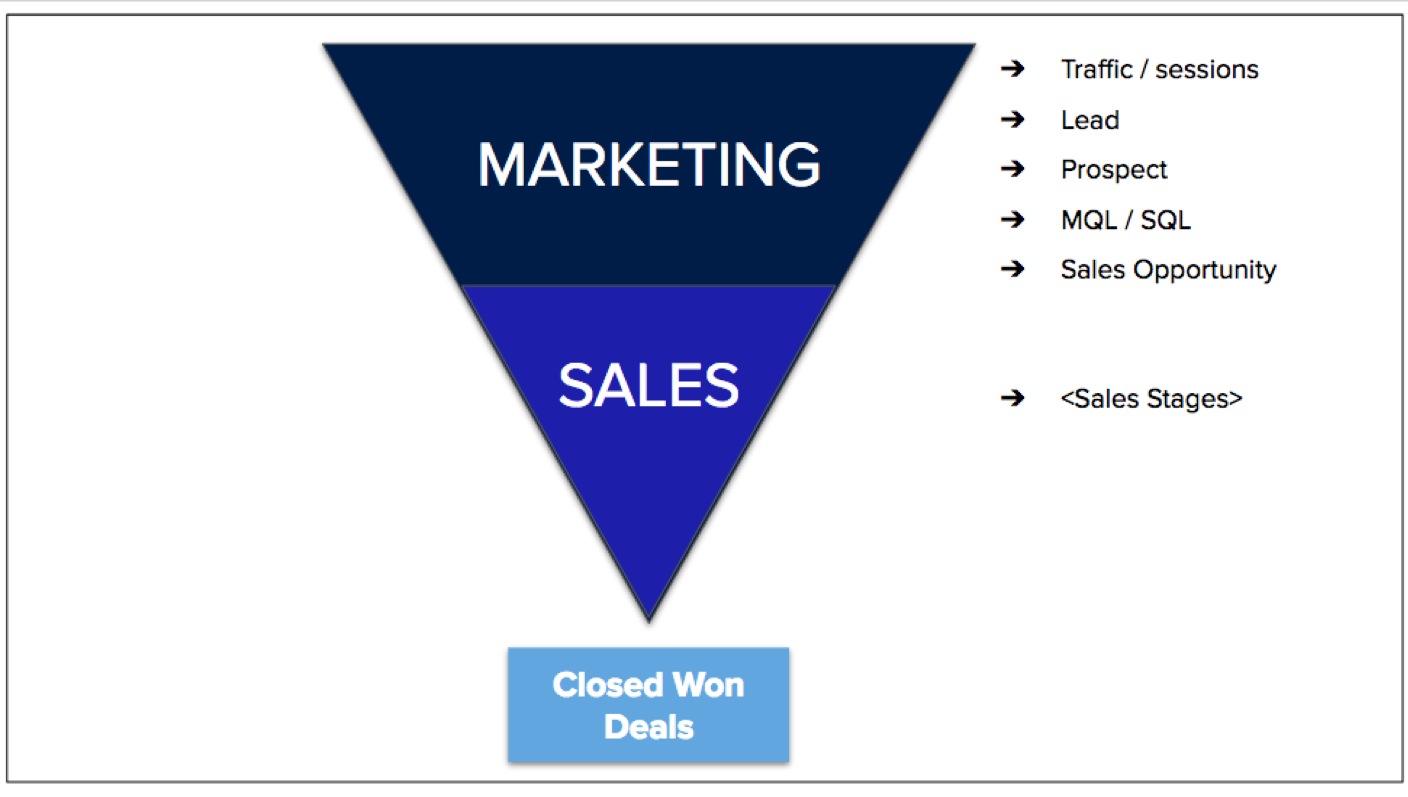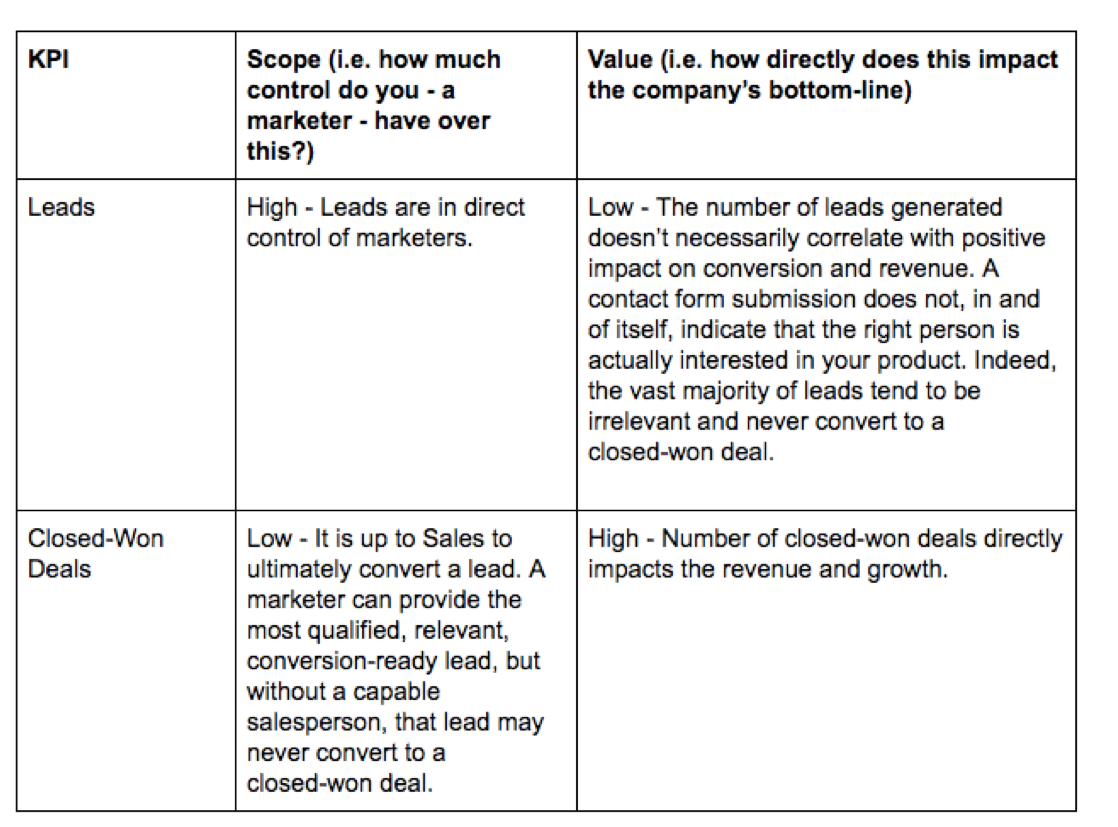Marketers rarely lack data. Whether it’s open rates, CTR, leads or conversions, we’re inundated with information. The problem, of course, is which information to pay attention to – which metrics to focus on.
Here at Blue Seedling, we focus on one main marketing Key Performance Indicator (KPI) to both measure and improve performance, and to communicate the impact our marketing activities have on a company’s growth. The purpose of this one metric is to provide us with important information that we can use to make better decisions about our marketing strategy.
This doesn’t mean that we ignore all the other metrics, like landing page conversions or email open rates. These are important metrics to help us optimize our messaging and improve performance across channels (hint: neither of these is our favorite KPI).
But, when it comes to creating, assessing, and justifying a marketing strategy and budget to your team or to senior leadership, you need one solid KPI that will quickly convey performance.
Curious?
Keep reading to learn which marketing KPI is our favorite and why.
Wait, what’s wrong with leads and closed-won deals?
Before we share what our favorite KPI is, let’s talk about some common B2B KPIs, and the challenges with each.
A few common marketing KPIs are:
- Leads, MQLs, SQLs: A lead is generally defined as a person expressing their interest in your product or service. This can be in the form of a person sharing their contact details at a conference, submitting an online contact form, or any other action that indicates interest (e.g. downloading an ebook and providing contact information). Since a lead only represents potential interest, it’s a top-of-the-funnel metric, far from closed-won deals and revenue. Similar to leads, there are additional stages in the funnel, like MQLs and SQLs (see image below). However, because their definitions vary widely among companies, we won’t be covering them in this post. Like leads, they are considered top-of-the-funnel metrics and they’re not very close to revenue.
- Closed-Won Deals: A closed-won deal is generally defined as a new sale. Since closed-won deals directly impact revenue, this is a bottom-of-the-funnel metric (as you can see below).

Typical marketing and sales funnel.
In most companies, marketers are directly responsible for incoming leads and salespeople are directly responsible for converting these leads into closed-won deals (=closing the sale).
A framework for choosing a primary KPI
When deciding which KPI to focus on, marketers should consider two things: scope and value. Scope refers to how much control the marketing team has over the outcome of a metric, and value refers to how valuable, or close to revenue, the metric is.

As you can see, neither of these metrics is, well, awesome…
What if there was a KPI that was under the marketing team’s scope AND was sufficiently correlated with revenue?
Well, you’re in luck! There is, and it’s called Sales Opportunities (using Salesforce terminology).
Oh, and it’s our favorite marketing KPI to track.
Our favorite marketing KPI: Sales Opportunities
A Sales Opportunity is a meeting (in-person, call, video, etc.) on the calendar with the right person at the right company.
- Meeting on the calendar: Clear action that can be quantified, i.e. # of meetings scheduled/month
- Right person: According to your persona analysis, this includes department, title, etc.
- Right company: Again, according to your persona analysis, this includes industry, size of company, etc.
We won’t go into persona analysis in this post, but an example of the Right person at the Right Company can be something like: Director level and above, in Marketing or e-commerce, at Fortune 500 retailers in the NYC area.
The reason we believe this is the most important KPI is because:
- Scope: This metric is still under direct control of the marketing team.
- Value: This is the highest-intent metric before the marketing to sales hand-off, and thus is ‘closest to revenue’ for marketers.
In other words, while we believe that other metrics are important, the end-goal is to a close a deal. Sales Opportunities is the closest KPI to the deal that is still controlled by the marketing team.
This is especially important when you’re presenting your marketing strategy to senior leadership. Chances are your CEO and finance lead care more about closed-won deals than email open rates.
Moreover, Sales Opportunities is an excellent equalizer across channels. Many marketers use different KPIs for different channels, i.e. open rates for emails or CPC for Facebook or Linkedin campaigns, which makes it difficult to compare performance across channels.
With Sales Opportunities you can use the same metric to compare performance across all your channels, which is the easiest, clearest way to demonstrate a unified picture of marketing performance and success. Plus, the fewer metrics you’re focused on, the easier it is to focus your team’s efforts and resources on the things that matter.
When Sales Opportunities isn’t the most important KPI
As usual, there are certain situations where you’ll want to track a different marketing KPI.
At Blue Seedling, we primarily work with Israeli early stage, high growth B2B companies. This means that the primary focus of the marketing team is bringing in new clients, which means new sales.
However, for later-stage companies with significant market share, marketing teams could be focused on upselling to existing customers, rather than getting new clients. In this scenario, the team may choose to focus on a KPI such as Market Share or Upsell to existing clients.
Therefore, the KPI you track will vary depending on the stage of the company, its current market share, and possibly other variables based on the high-level goals of the company, such as geographical expansion, product line expansion, brand awareness, and others.
Got it, now what?
Now that you’ve decided on your #1 metric, it’s time to get to work.
The first thing you can do is create a new marketing plan that includes a marketing budget and strategy based on Sales Opportunities. To create this plan, you should calculate your cost-per-sales-opportunity, and cost-per-closed deal and compare them across your marketing channels. Once you’ve done this analysis, you can decide which marketing channels are most effective at reaching your goals.
Need help? We created a free marketing budget spreadsheet to help you get started.
The bottom line
Try to analyze your marketing activities and resources according to how well they contribute to your one KPI: Sales Opportunities.
This will make it easier for you to create a unified marketing strategy, and clearly communicate marketing performance to your team and senior leadership.
But wait, there’s more
Want to learn more about marketing KPIs, and marketing strategy in general?
Check out our video on Building a Marketing Strategy and Plan (as part of our B2B Marketing Workshop for Microsoft ScaleUp in Israel).
(hint: you can jump to 1:18 to learn about KPIs)








